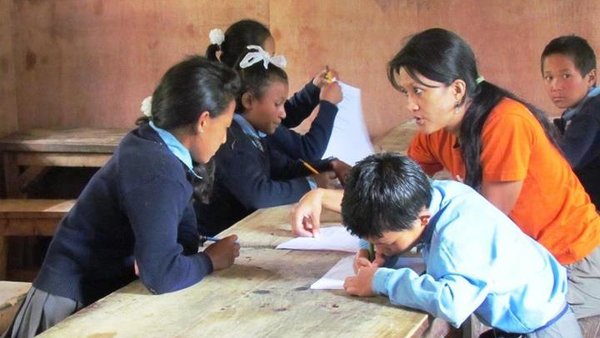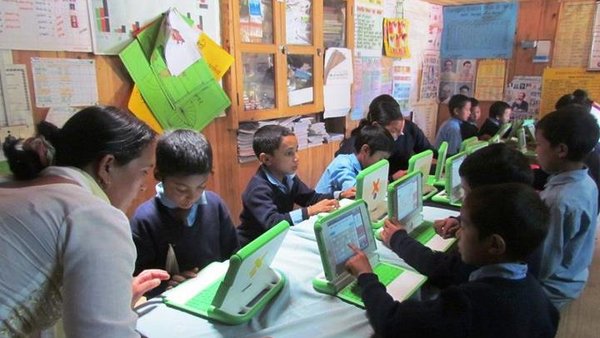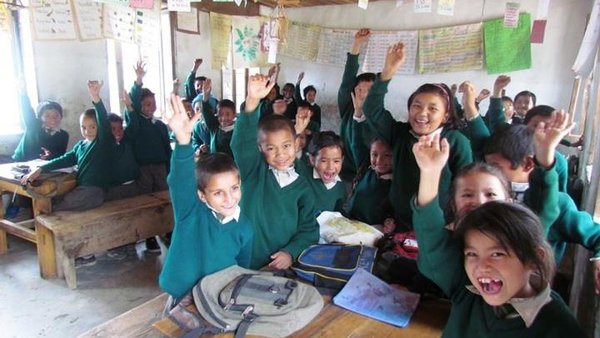Imagine. A million bits of information hatching into life, fissioning into a billion more, flying across plains, hills and mountains. On arriving at destinations where sometimes no roads, boats or even aeroplanes can reach, every single one of the million bits manage to fall in just the right places to together make identical copies of the shell from which they initially hatched. This process of fission and subsequent fusion is happening even as we speak. These bits are spreading far and wide, creating shells of information that become knowledge for anyone fortunate enough to open them. An education epidemic growing viral far and wide, like something out of a science fiction.
Like all science fiction, this one too is a metaphor : one of the work at Open Learning Exchange Nepal. People at the office work for months to fill empty shells, E-Paatis (laptops), with bits of information, content. This information is cloned onto many more laptops and pendrives, one of which sat in my pocket and flew all the way to Solukhumbu. Our team of five -- consisting of Sarina di, Tika sir, Sunil sir, Kayo and myself -- carried with us the responsibility to update the existing E-Paatis of the schools. The new version of NEXO had 120 new paaths(lessons) in science and bigyan. Once update began, the cells of information in the E-Paatis turned first black and then blue and then green, and magically were ready for use. When children started accessing and eventually understanding the information stored, they became knowledgeable enough to answer the questions to the paaths they had just learnt. The sounds “thik” (correct) and “milena” (incorrect) that were once ringing in the rooms of our office were now unanimously emanating from these E-Paatis hundreds of kilometers away, telling the children if what they answered was correct or not; signals from another world.
Sarina di and I gave baseline surveys to the children to see how they would attempt to answer the type of questions one would encounter when using an E-Paati. There was a range of reactions amongst the different schools and even amongst children within the same school. There was genuine excitement, bewildered indifference, and other things in between. For example, on the question “Connect the dots to complete the picture of a cat,” some children jumped at joining the dots, an excited few totally disregarded the dots and made their own cats, a confused many complained that they did not know how to make a cat and the majority did not even attempt, let alone interpret, the questions and rather resorted to asking us for help. “Miss? Miss! Miss!!! Miss?! Miss?????? Mmm..” We often found ourselves penetrating through a hard space of earnest requests, softening confusion. It was challenging. But a lot of children, especially those from Garma, made me realize that teaching was as fulfilling as it was challenging. These children were completely absorbed in what they were doing and easily picked up any new concept that we taught them. They were like balm on wound. The wound was my own premature assumption that children in rural areas were deprived of the tools for a quality education. The balm was the realization that these children had the best tool -- the want for an education.

The surveys brought us overwhelmingly close to the children’s minds. We could almost touch their learning, play with it. We tried to give them what we could. Sometimes they took what we gave them but for the most part they did not. Their inhibitions were much too deep for us to fathom, let alone alleviate, in the one hour that we had. No matter how hard we tried, we would eventually find ourselves against a wall. We theorized, out of observation, why the wall was there: children did not attempt to read the questions; when they did, they did not understand them; when they did understand them, they did not know how to answer them and when they did know how to answer, they were not sure if they should. These children clearly felt like they did not have the right to know. The only way to deal with the theory was to deny it. That too we could not do, given the intensity with which the evidence was staring at us from every corner of the room.
We are only a retrospect away from the realms of a child’s mind because we ourselves were children to begin with. As a child, did I ever feel like I did not have the right to know? In retrospect: yes, more often than not. I think that children are so inquisitive and sharp that they can outsmart any education system. A boy in Garma asked me what 13 meant on the digital clock. I asked him what he thought. He hung his head as if in shame. I could tell that he knew the answer. I got frustrated, not for myself but for him because I knew exactly what he was feeling; the fear of being judged. After a long pause, punctuated with my goading, he finally said “1 PM!”. The question he asked was not on the survey and was probably bothering him for a while. It is sad that earlier he felt that he did not have the right to question and sadder still that when he did question, he could not jump at an answer like he ought to have.
Imagine. A super teacher that not only knows Science, Math, English and Nepali but is also diligent enough to teach a thousand students at once without compromising the quality of education she gives to any one. She has both the rigor and the vigor. She is a breacher of the classical theory that one can’t be in two places at once, a muse for quantum theorists. In any given moment, she can be in multiple locations, telling a variety of things to a variety of children. Wake her up at 2 in the morning and ask her a question that is keeping you from sleeping and Eureka! she has the answer. A genie -- except that she grants unlimited wishes of enquiry and does not belong to any one master-- and a very trust-worthy one at that; she does not disclose to the world the questions you ask and the doubts you have. You are spared the fright of questioning or of even answering.

E-Paath is a child’s wildest imagination come true. "E-Paati!" is the new "Eureka!" This is literally to say that a "Eureka! moment" translates to an "E-Paati! moment." Children that had been using E-Paati for quite a while, especially those in Garma, seemed to associate understanding with E-Paati. For instance, children would intensely stare at their papers in a dire attempt to understand the question. When they did finally see what was being shown, they would shout "E-Paati!" Their exclamation probably sprouted from the realization that the question was something they had seen earlier in E-Paati, but they said it so often and with so much enthusiasm that one could not help but think that the word "E-Paati!" was an exclamation of understanding and learning!
Learning can be spontaneous. This is best exemplified by children who have never played with technology before but when given a new cell phone, can know the ins and outs of its functions in less than an hour. Their natural presence of mind helps them grasp new concepts without the need for any pre-requisites. My going to the schools as the children’s "Miss!" changed the way these children functioned in front of me. Like the little boy who could not confidently tell me that 13 meant 1 PM, children, I noticed, acknowledged my presence by giving me their silence and giving up their natural mindfulness. A lot of children we met did not know the name of their schools. While some did not make any effort at all to somehow get their school's name on paper, a smart few copied the name from their own, or another's, school sweaters; an act of spontaneous learning, of being mindful in the present with the intention of learning something right here, right now. Some children could read Nepali but not comprehend it. If it was English that the children could read but not understand, then I would understand. But Nepali? Isn’t hearing oneself read Nepali the same as listening to someone speak to you in Nepali? If you can converse with me in Nepali, then why can’t you understand what you are reading to yourself? Why the pretense of incomprehension? These children were clearly waiting for my approval to understand.
As a kid, I had moments when I thought that it was my ignorance of certain knowledge on which the purpose of a teacher was built. As such, to know was to destroy that purpose and to not know was to respect it. My many questions and sometimes even answers have come out as nothing but silence. It probably is the positioning of a teacher and a student on a vertical plane, with the teacher at the top, that by default creates this psychology. Or maybe it is the term "teacher" itself, which wrongly defines a person as someone who teaches rather than as someone who assists a student in their personal learning. No matter what the explanation, it does not justify the relationship. I was pleased beyond measure to see that E-Paati can bring a change.
Our field visit made me see how E-Paati can help teachers help children. Children can open any activity they like and interact with it in any way they wish. After learning a lesson from a teacher, children can visit paaths they feel most inclined to visit and revisit the ones they feel are most deserving of revision. Despite the immense power that this seemingly-a-child’s-toy possesses, it does not intimidate a child but on the contrary, motivates curiosity. The E-Paati will never say "How many times do I need to answer the same question?!" Children will finally feel like they have the right to know. As such, the E-Paatis wonderfully complement a teacher’s lesson plans. The teachers too complement the purpose of an E-Paati by helping students make effective use of it. Also, the teacher's relationship with students can better once children start shedding inhibitions through their E-Paati experience, which entails exploration, self-assessment, and self-discovery. Win-win. Such thoughts are far-fetched considering how little these schools have worked with the E-Paatis, but they conjure a beautiful picture of the state of tomorrow’s education. Education can be a playground where children play free, with the teachers teaching them not what to play but just how to play safe. Each child plays a unique combination of games without feeling the need to catch up or slow down. They receive an education as unique as they are.
Imagine.
